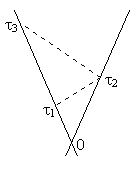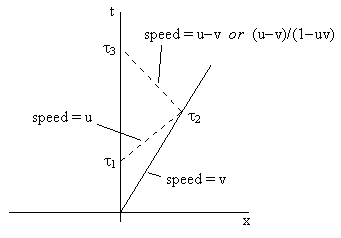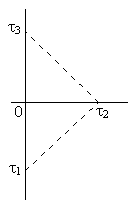2.1 The Spacetime Interval
The advance of the quantum wave function of any physical system as it passes uniformly from the event (t,x,y,z) to the event (t+dt, x+dx, y+dy, z+dz) is proportional to the value of dt given by
![]()
where t,x,y,z are any system of inertial coordinates and c is a constant (the speed of light, equal to 300 meters per microsecond). The quantity dt is called the elapsed proper time of the interval, and it is invariant with respect to any system of inertial coordinates. To illustrate, consider a muon particle, which has a radioactive mean life of roughly 2 msec with respect to its inertial rest frame coordinates. In other words, between the appearance of a typical muon (arising from, say, the decay of a pion) and its decay is an interval of about 2 m sec in terms of the time coordinate of the muon's inertial rest frame, so the components of this interval are {2,0,0,0}, and the quantum phase of the particle advances by an amount proportional to dt, where
![]()
Now suppose we assess this same physical phenomenon with respect to a relatively moving system of inertial coordinates, e.g., a system with respect to which the muon moved from the spatial origin [0,0,0] all the way to the spatial position [980m, -750m, 1270m] before it decayed. With respect to these coordinates, the muon traveled a spatial distance of 1771 meters. Since the advance of the quantum wave function (i.e., the proper time) of a system or particle over any interval of its worldline is invariant, the corresponding time component of this physical interval with respect to these relatively moving inertial coordinates must be much greater than 2 m sec. If we let (dT,dX,dY,dZ) denote the components of this interval with respect to the relatively moving system of inertial coordinates, we must have
![]()
Solving for dT and substituting for the spatial components noted above, we have
![]()
This represents the time component of the muon decay interval with respect to the moving system of inertial coordinates. Since the muon has moved a spatial distance of 1771 meters in 6.23 msec, we see that its velocity with respect to these coordinates is 284 m/m sec, which is 0.947c.
The identification of the spacetime interval with quantum phase applies to null intervals as well, consistent with the fact that the quantum phase of a photon does not advance at all between its emission and absorption. (For a further discussion of this, see Section 9.10.) Hence the physical significance of a null spacetime interval is that the quantum state of any system is constant along that interval. In other words, the interval represents a single quantum state of the system. It follows that the emission and absorption of a photon must be regarded as, in some sense, a single quantum event.
Note, however, that the quantum phase is path dependent. In other words, two particles at opposite ends of a lightlike (null) interval do not share the same quantum state unless the second particle reached that event by passing along that null interval. Hence the concept of the spacetime interval as a measure of the phase of the quantum wave function does not conflict with the exclusion principle for fermions such as electrons, because even though two electrons can be null-separated, they cannot have separated along that null path, because they have non-zero rest mass. Of course, it is possible for two photons at opposite ends of a null interval to have reached that condition by progressing along that interval, in which case they represent the same quantum phase (and in some sense may be regarded as "the same photon"), but photons are bosons, and hence not excluded from occupying the same state. In fact, the presence of one boson in a particular quantum state actually enhances the probability of another photon entering that state. (This is responsible for the phenomenon of stimulated emission, which is the basis of operation of lasers.)
In this regard it's interesting to consider neutrinos, which (like electrons) are fermions, meaning that they have anti-symmetric eigenfunctions, and hence are subject to the Pauli exclusion principle. On the other hand, neutrinos were traditionally regarded as massless, meaning that they propagate along null intervals. This raises the prospect of two instances of a neutrino at opposite ends of a null interval, with the second occupying the same quantum state as the first, in violation of the exclusion principle for fermions. It might be argued that these two instances are really the same neutrino, and a particle obviously can't exclude itself from occupying its own state. However, this is somewhat problematic due to the indistinguishability and the lack of definite identities for individual particles. A different approach would be to argue that all fermions, including neutrinos, must have mass, and thus be excluded from traveling along null intervals. The idea that neutrinos actually do have mass seems to be supported by recent experimental observations, but the questions remains open.
Based on the general identification of the invariant magnitude (proper time) of a timelike interval with quantum phase along that interval, it follows that all physical processes and characteristic sequences of events will evolve in proportion to this quantity. The name "proper time" is appropriate because this quantity represents the most meaningful known measure of elapsed time along that interval, based on the fact that the quantum state is the most complete possible description of physical reality. Since not all spacetime intervals are timelike, we conclude that the temporal relations between events induce only a partial ordering, rather than a total ordering (as discussed in Section 1.2), because a set of events can be totally ordered only if they are each inside the future or past null cone of each of the others. This doesn't hold if any of the pairwise intervals is spacelike. As a consequence of this partial ordering, between two fixed timelike separated events there exist timelike paths with different lapses of proper time.
Admittedly a partial ordering of events has been considered unacceptable by some people, basically because they regard total temporal ordering in a classical Cartesian setting as an inviolable first principle. Rather than accept partial ordering they prefer to (more or less arbitrarily) select one particular inertial reference system and declare it to be the "true" configuration, as in Lorentz's original theory, in an attempt to restore an unambiguous total temporal ordering to events. They then account for the apparent differences in elapsed time (as in muon observations) by regarding them as effects of absolute velocity relative to the "true" frame of reference, again following Lorentz. However, unlike Lorentz, we now have a theory of quantum mechanics, and the quantum state of a system gives (arguably) the most complete possible objective description of the system. Therefore, modern advocates of total temporal ordering face the daunting task of finding some mechanism underlying quantum mechanics (i.e., hidden variables) to provide a physical significance for their preferred total ordering. Unfortunately, the only prospects for a viable hidden-variable theory seem to be things like the explicitly non-local contrivances described by David Bohm, which must surely be anathema to those who seek a physics based on classical Cartesian mechanisms. So, although the theories of relativity and quantum mechanics are in some respects incongruent, it is nevertheless true that the (putative) validity and completeness of quantum mechanics constitutes one of the strongest argument in favor of the relativistic interpretation of Lorentz invariance.
We should also mention that a tacit assumption has been made above, namely, the assumption of physical equivalence between instantaneously co-moving frames, regardless of acceleration. For example, we assume that two co-moving clocks will keep time at the same instantaneous rate, even if one is accelerating and the other is not. This is just a hypothesis - we have no a priori reason to rule out physical effects of the 2nd, 3rd, 4th,... time derivatives. It just so happens that when we construct a theory on this basis, it works pretty well. (Similarly we have no a priori reason to think the field equations necessarily depend only on the metric and its 1st and 2nd derivatives; but it works.)
Another way of expressing this "clock hypothesis" is to say that an ideal clock is unaffected by acceleration, and to regard this as the definition of an "ideal clock", i.e., one that compensates for any effects of 2nd or higher derivatives. Of course the physical significance of this definition arises from the hypothesized fact that acceleration is absolute, and therefore perfectly detectable (in principle). In contrast, we hypothesize that velocity is perfectly undetectable, which explains why we cannot define our "ideal clock" to compensate for velocity (or, for that matter, position). The point is that these are both assumptions invoked by relativity: (1) the zeroth and first derivatives of position are perfectly relative and undetectable, and (2) the second and higher derivatives of position are perfectly absolute and detectable. Most treatments of relativity emphasize the first assumption, but the second is no less important.
The notion of an ideal clock takes on even more physical significance from the fact that there exist physical entities (such a vibrating atoms, etc) in which the intrinsic forces far exceed any accelerating forces we can apply, so that we have in fact (not just in principle) the ability to observe virtually ideal clocks. For example, in the Rebka and Pound experiments it was found that nuclear clocks were slowed by precisely the factor g (v), even though subject to accelerations up to 1016 g (which is huge in normal terms, but of course still small relative to nuclear forces).
It was emphasized in Section 1 that a pulse of light has no inertial rest frame, but this may seem puzzling at first. The pulse has a well-defined spatial position versus time with respect to some inertial coordinate system, representing a fixed velocity c relative to that system, and we know that any system of orthogonal coordinates in uniform non-rotating motion relative to an inertial coordinate system is also inertial, so why can we not simply apply the velocity c to the base frame to arrive at the rest frame of the light pulse? How can an entity have a well-defined velocity and yet have no well-defined rest frame? The only answer can be that the transformation is singular, i.e., the coordinate system moving with a uniform speed c relative to an inertial frame is not well defined. The singular behavior of the transformation corresponds to the fact that the absolute magnitude of the spacetime intervals along lightlike paths is null. The transformation through a velocity v from the xt to the x't' coordinates is t' = (t-vx)/g and x' = (x-vt)/g where g = (1-v2)1/2, so it's clear that for v = � 1 the individual t' and x' components are undefined, but the ratio of dt' over dx' remains well-defined, with magnitude 1 and the opposite sign from v. The singularity of the Lorentz transformation for the speed c suggests that the conception of light as an entity in itself may be somewhat misleading, and it is often useful to regard light as simply an interaction between two massive bodies along a null spacetime interval.
Discussions of special relativity often refer to the use of clocks and reflected light signals for the evaluation of spacetime intervals. For example, suppose two identical clocks are moving uniformly with speeds +v and -v along the x axis of a given inertial coordinate system, and these clocks are set to zero at the intersection of their worldlines. When the leftward clock indicates the proper time t1, it emits a pulse of light, which bounces off the rightward clock when that clock indicates t2, and arrives back at the leftward clock when that clock reads t3. This is illustrated in the drawing below.

By similar triangles we immediately have t2/t1 = t3/t2, and thus t22 = t1t3. Of course, this same relation holds good in Galilean spacetime as well (not to mention Euclidean plane geometry, using distances instead of time intervals), and the reflected signal need not be a light pulse. Any object moving at the same speed (angle) in both directions with respect to this coordinate system would serve just as well, and would lead to the same result that t2 is the geometric mean of t1 and t3. Naturally if we apply any Minkowskian, Galilean, or Euclidean transformation (respectively), the pictorial angles of the lines will differ, but the three absolute intervals will remain unchanged.
It is, of course, possible to distinguish between the Galilean and Minkowskian cases based just on the values of the elapsed times, provided we know the relative speeds of the clocks and the signal. In Galilean spacetime each proper time tj equals the coordinate time tj, whereas in Minkowski spacetime it equals (tj2 - xj2)1/2 where xj = � v tj. Hence the proper time tj in Minkowski spacetime is tj(1 - v2)1/2. This might seem to imply that the ratios of proper times are the same in the Galilean and Minkowskian cases, but in fact we have not made a valid comparison for equal relative speeds between the clocks. In this example each clock is moving with speed v away from the midpoint, which implies that the relative speed is 2v in the Galilean case, but only 2v/(1 + v2) in the Minkowskian case.
To give a valid comparison for equal relative speeds between the clocks, let's transform the events to a system of coordinate such that the left-hand clock is stationary and the right-hand clock is moving at the speed v. Now this v represents magnitude of the actual relative speed between the two clocks. We now stipulate that the original signal is moving with speed u relative to the left-hand clock, and the reflected signal is moving with speed -u relative to the right-hand clock. The situation is illustrated in the figure below.

The speed, with respect to these coordinates, of the reflected signal is what distinguishes the Galilean from the Minkowskian case. Letting x2 and t2 denote the coordinates of the reflection event, and noting that t1 = t1 and t3 = t3, we have v = x2/t2 and u = x2/(t2-t1). We also have
![]()
Dividing the numerator and denominator of the expression for u by t2, and replacing x2/t2 with v, gives u = v/[1-(t1/t2)]. Likewise the above expressions can be written as

Solving these equations for the time ratios, we have

Consequently, depending on whether the metric is Galilean or Minkowskian, the ratio of t3 over t1 is given by
![]()
respectively. If u happens to be unity (meaning that the signals propagate at the speed of light), these expressions reduce to the squares of the Galilean and relativistic Doppler shift factors, i.e., 1/(1-v)2 and (1+v)/(1-v), discussed more fully in Section 2.4.
Another distinguishing factor between the two metrics is that with the Minkowski metric the speed of light is invariant with respect to any system of inertial coordinates, so (arguably) we can even say that it represents the same "u" relative to a spacelike interval as it does relative to a timelike interval, in order to adhere to our stipulation that the reflected signal has the speed u relative to "the rest frame of the right-hand clock". Of course, a spacelike interval cannot actually be the worldline of a clock (or any other material object), but the invariance of the speed of light under Minkowskian transformations enables us to rationally apply the same "geometric mean" formula to determine the magnitudes of spacelike intervals, provided we use light-like signals, as illustrated below.

In this case we have t1 = -t3, so t22 = -t32, meaning that squared spacelike intervals are negative.